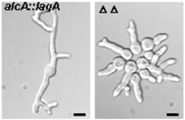Chemistry, Department of: Faculty Series

Liangcheng Du Publications
Document Type
Article
Date of this Version
5-31-2016
Citation
Scientific Reports 6:26881 (2016). DOI 10.1038/srep26881
Abstract
Lysobacter species are Gram-negative bacteria that are emerging as new sources of antibiotics, including HSAF (Heat Stable Antifungal Factor), which was identified from L. enzymogenes with a new mode of action. LesR, a LuxR solo, was recently shown to regulate the HSAF biosynthesis via an unidentified mechanism in L. enzymogenes OH11. Here, we used a comparative proteomic approach to identify the LesR targets and found that LesR influenced the expression of 33 proteins belonging to 10 functional groups, with 9 proteins belonging to the TBDR (TonB-Dependent Receptor) family. The fundamental role of bacterial TBDR in nutrient uptake motivates us to explore their potential regulation on HSAF biosynthesis which is also modulated by nutrient condition. Six out of 9 TBDR coding genes were individually in-frame deleted. Phenotypic and gene-expression assays showed that TBDR7, whose level was lower in a strain overexpressing lesR, was involved in regulating HSAF yield. TBDR7 was not involved in the growth, but played a vital role in transcribing the key HSAF biosynthetic gene. Taken together, the current lesR-based proteomic study provides the first report that TBDR7 plays a key role in regulating antibiotic (HSAF) biosynthesis, a function which has never been found for TBDRs in bacteria.
Includes Supplementary materials.


Comments
This work is licensed under a Creative Commons Attribution 4.0 International License.